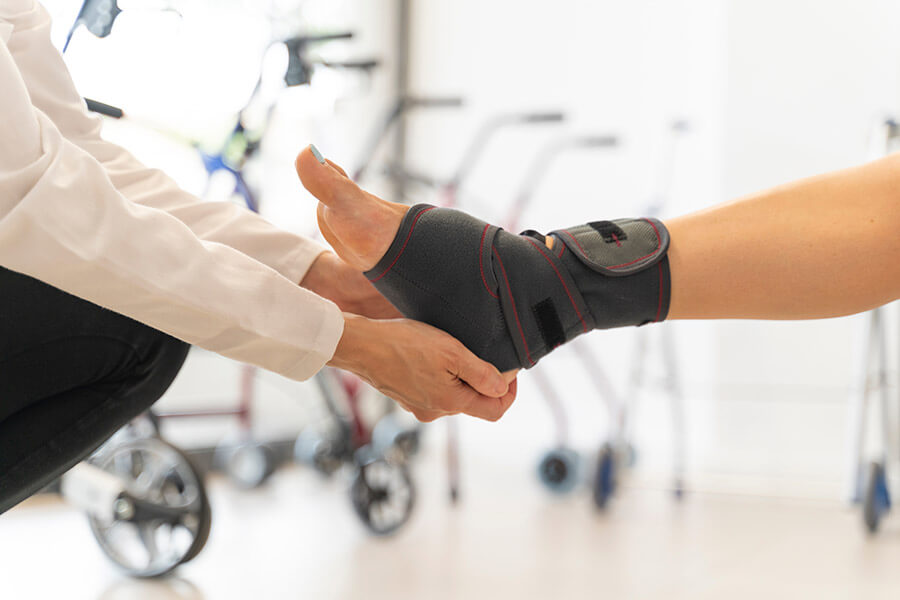- Find a Doctor
- Services & Specialties
-
-
Services & Specialties
-
-
-
-
- Find a Location
-
-
Find a Location
More than 100 independent, locally owned locations in neighborhoods across the state of Washington. Explore our:
-
-
-
-
- News & Resources
-
-
News & Resources
- Welcome Our Newest Doctors
- Latest News
- Learn More About Our Surgery Centers
- Why Proliance Surgeons?
- Meet Our Leadership
- Meet Our Board
- Contact Us Today
- Pay My Bill
- Career Opportunities
- Mission, Vision, Values
- Phreesia FAQ
- Insurance Plans
- Medical Records
- Balance Billing Protection Act
- PELTO Health Partners
- Revenue Cycle Credit Resolution
- Proliance Surgeons Foundation
-
-
-
-
- Pricing
Ankle Conditions: Ankle Disorders
The ankle is a complex joint, where the tibia (shin bone), fibula (calf bone), and talus bone meet. The ankle ultimately joints the foot with the lower leg and contains a range of soft tissues and nerves. Many disorders and conditions can affect the ankle, causing pain and limiting range of motion, requiring treatments from at-home care to surgical intervention.

What is the Ankle Joint: Ankle Anatomy
The ankle is a synovial joint that consists of cartilage, muscles, ligaments, and nerves, connecting the foot to the lower leg. A synovial joint is any joint that has the most amount of freedom in movement, though the ankle also functions like a hinge joint. Anytime a person is moving, the ankle bends and flexes to help maintain balance and provide stability.
Along with the three bones listed earlier (tibia, fibula, and talus), the ankle also consists of three main sets of ligaments:
- Medial ligaments: four ligaments that start at the bottom end of the shin bone and fan out to connect the heel bone, talus, and navicular bones in the foot.
Lateral ligaments: three ligaments that start at the lateral malleolus (the bump on the outside of the ankle, and connect to the talus and calcaneus. - Syndesmotic ligaments: Four ligaments that connect the tibia and fibula.
Ankle Anatomy (cont.)
The ankle also consists of many muscles that are attached to the legs and feet to control the ankle’s movements:
- Gastrocnemius
- Soleus
- Plantaris
- Tibialis posterior
- Flexor digitorum longus
- Flexor hallucis longus
- Peroneus brevis
- Peroneus longus
- Tibialis anterior
- Extensor digitorum longus
- Extensor hallucis longus
- Peroneus tertius
The ankle also possesses specific nerves and blood vessels:
- Tibial nerve
- Superficial peroneal nerve
- Deep peroneal nerve
- Anterior tibial artery
- Posterior tibial artery
- Peroneal artery
Common Conditions of the Ankle: Ankle Pain Causes
The ankle is a complex part of the body, allowing for a range of disorders and conditions to develop from an array of sources. Some of the most common ankle problems include:
Sprained ankle: Occurs when the ligaments surrounding the ankle joint are stretched or torn, often due to sudden twisting or rolling of the foot. Symptoms include pain, swelling, bruising, and difficulty bearing weight.
Achilles tendinitis: Inflammation of the Achilles tendon, which connects the calf muscles to the heel bone. Commonly caused by overuse or repetitive stress, resulting in pain and stiffness along the back of the ankle and lower leg.
Ankle arthritis: Degeneration of the cartilage in the ankle joint, leading to pain, stiffness, swelling, and limited range of motion. It can result from aging, previous injuries, or inflammatory conditions.
Ankle impingement syndrome: Occurs when soft tissues become pinched or compressed within the ankle joint during movement, causing pain and limited mobility, often due to bone spurs or inflamed tissues.
Ankle instability: Characterized by recurrent “giving way” or feelings of instability in the ankle joint, often due to previous sprains or ligament damage, leading to chronic ankle instability and increased risk of further injury.
Peroneal tendonitis: Inflammation or irritation of the peroneal tendons, which run along the outer side of the ankle and help stabilize the foot. It can cause pain, swelling, and weakness, typically due to overuse or repetitive activities.
Ankle fractures: Breaks or cracks in one or more of the bones that make up the ankle joint, often caused by trauma or injury, resulting in pain, swelling, bruising, and difficulty bearing weight.
Tarsal tunnel syndrome: Compression of the tibial nerve as it passes through the tarsal tunnel, located on the inner side of the ankle. Symptoms include pain, tingling, burning sensations, and numbness in the ankle and sole.
Plantar fasciitis: Inflammation of the plantar fascia, a thick band of tissue that runs along the bottom of the foot and connects the heel bone to the toes. It causes heel pain, especially with the first steps in the morning or after long periods of rest, often due to overuse or strain on the foot.
Available Treatments For Conditions of the Ankle
Treating ankle problems can range from at-home care to non-invasive treatments and surgical intervention. The following treatments are generally recommended for the conditions they’re listed beneath:
Sprained Ankle
- R.I.C.E. (Rest, Ice, Compression, Elevation)
- Pain relievers (e.g., ibuprofen, acetaminophen)
- Immobilization with a brace or splint
- Physical therapy for rehabilitation
- Surgical repair or reconstruction (e.g., arthroscopic ligament repair) in severe cases with significant ligament damage
Achilles Tendonitis
- Rest and activity modification
- Ice therapy
- Nonsteroidal anti-inflammatory drugs (NSAIDs)
- Stretching and strengthening exercises
- Orthotics or heel lifts
- Physical therapy
- Extracorporeal shockwave therapy
- Corticosteroid injections (in severe cases)
- Surgical intervention (e.g., debridement, tendon transfer) in chronic cases
Ankle Arthritis
- Medications (e.g., NSAIDs, corticosteroid injections)
- Physical therapy and exercise
- Assistive devices (e.g., braces, orthotics)
- Weight management
- Joint injections (e.g., hyaluronic acid)
- Surgical options such as ankle fusion (arthrodesis) or ankle replacement (arthroplasty)
Ankle Impingement Syndrome
- Rest and activity modification
- NSAIDs
- Physical therapy for stretching and strengthening
- Steroid injections
- Surgical options may include arthroscopic debridement or open surgical removal of bone spurs (osteophytes)
Ankle Instability
- Physical therapy for strengthening and proprioception training
- Bracing or taping for support
- Orthotics
- Surgical options such as ligament repair or reconstruction (Broström-Gould procedure) in severe cases
Peroneal Tendonitis
- Rest and activity modification
- Ice therapy
- NSAIDs
- Physical therapy for stretching and strengthening
- Orthotics or supportive footwear
- Corticosteroid injections (in severe cases)
- Surgical options may include tendon debridement, repair, or tenosynovectomy
Ankle Fractures
- Immobilization with a cast or brace
- Pain management medications
- Surgery, such as open reduction and internal fixation (ORIF) for realignment and stabilization
Tarsal Tunnel Syndrome
- Rest and activity modification
- NSAIDs
- Orthotics or supportive footwear
- Corticosteroid injections
- Physical therapy
- Surgical decompression of the tibial nerve (tarsal tunnel release)
Plantar Fasciitis
- Rest and activity modification
- Stretching exercises
- Night splints
- Orthotics or supportive footwear
- Ice massage
- NSAIDs
- Corticosteroid injections
- Extracorporeal shockwave therapy
- Platelet-rich plasma (PRP) injections
- Surgical options such as plantar fascia release in refractory cases


